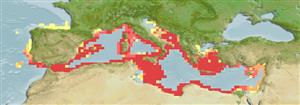Cephalopoda |
Octopoda |
Octopodidae
Environment: milieu / climate zone / depth range / distribution range
Ecology
Benthic; depth range 70 - 700 m (Ref. 96968), usually 250 - 500 m. Subtropical; 45°N - 27°N, 14°W - 37°E
Mediterranean Sea and Northeast Atlantic: from Spain south to Morocco, and the Mediterranean.
Length at first maturity / Size / Weight / Age
Maturity: Lm ? range ? - ? cm Max length : 16.5 cm ML male/unsexed; (Ref. 96968); max. published weight: 750.00 g (Ref. 96968)
Minimum depth from Ref. 105634. Benthic (Ref. 1970). Inhabits the lower continental shelf and upper slope. Feeds on crustaceans (Reptantia and Natantia), fish and cephalopods (Ref. 106837).
Life cycle and mating behavior
Maturity | Reproduction | Spawning | Eggs | Fecundity | Larvae
Members of the class Cephalopoda are gonochoric. Male and female adults usually die shortly after spawning and brooding, respectively. Mating behavior: Males perform various displays to attract potential females for copulation. During copulation, male grasp the female and inserts the hectocotylus into the female's mantle cavity where fertilization usually occurs. Life cycle: Embryos hatch into planktonic stage and live for some time before they grow larger and take up a benthic existence as adults.
Quetglas, A, M. Gonzales, A. Carbonell and P. Sánchez 2001 Biology of the deep-sea octopus Bathypolypus sponsalis (Cephalopoda: Octopodidae) from the wetern Mediterranean Sea. Mar. Biol. 138:785-792. (Ref. 1958)
IUCN Red List Status
(Ref. 130435: Version 2025-1)
CITES status (Ref. 108899)
Not Evaluated
Not Evaluated
Threat to humans
Human uses
Fisheries: commercial
| FishSource |
Tools
More information
Life cycleReproductionMaturityFecunditySpawningEggsEgg developmentLarvae PhysiologyOxygen consumption
Human RelatedStamps, coins, misc.
Internet sources
Estimates based on models
Preferred temperature
(Ref.
115969): 13.2 - 15, mean 14.2 (based on 117 cells).
Fishing Vulnerability
Low vulnerability (10 of 100).
